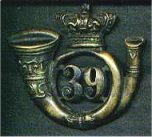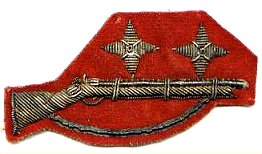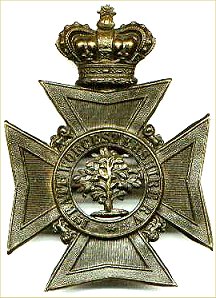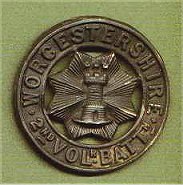Volunteer Regiments of Worcestershire (1798 - 1859 - 1914)
Men of Worcestershire have volunteered to defend their homeland since the first Volunteers of the Napoleonic era. The Volunteers of the Napoleonic era were both Cavalry and Infantry. The earliest in the County were the Worcester Cavalry, whose commissions are dated 1796. Details of these Volunteers have been gathered from War Office Lists and the “Volunteer Chart” published in 1808. The Volunteers in the County were as follows : — Bewdley Infantry Bromsgrove Cavalry |
1st Volunteer Battalion Worcestershire Regiment N.C.O.'s |
Droitwich Infantry
2 Companies. Earliest commission 15th September. 1803. Had a Chaplain and a Surgeon.
Volunteer Chart: 1808.
Strength: 155
Captain: C. Norbury.
Coat: Scarlet.
Facings: Buff.
Breeches: White.
Officers’ lace: Silver.
Dudley Cavalry
Commissions dated 11th October, 1803.
Volunteer Chart: 1808.
Strength: 49.
Captain: Tho. Brettell.
Facings, etc.— not given.
Loyal Dudley Infantry
Commissions dated 22nd November, 1803.
1805. “Loyal” omitted.
Volunteer Chart: 1808.
Strength: 232.
Lt.-Colonel: Hon. Jno. Wm. Ward.
Coat, etc., not given.
Elmley Lovett Infantry
One weak company.
Earliest commissions dated 15th September, 1803.
Volunteer Chart: 1808.
Strength: 66.
Captain: S. T. Forrester.
Coat, etc., not given.
Evesham and Pershore Infantry
Earliest commissions dated 24th November, 1803.
1805 Changed to East Worcester.
1808. Loyal Evesham and Pershore Battalion of Volunteer Infantry (Colonel Jeffry Amherst), 440 strong, in September became East Worcestershire Local Militia.
Feckenham Infantry
Commissions dated 6th September, 1803.
Volunteer Chart: 1808.
Loyal Feckenham Infantry.
Strength: 124.
Captain: Robert B. Waldron.
Coat Scarlet.
Facings: Buff.
Breeches : White
Officers’ Lace : Silver.
Hallow and Grimley Infantry
Earliest commission dated 15th September, 1803. Company omitted in 1805 list.
Hanbury Infantry
Commissions dated 6th September, 1803.
Volunteer Chart: 1808.
Hanbury Light Infantry.
Strength: 123.
Captain: Jno Weir.
Coat : Scarlet.
Facings: Buff.
Breeches: White.
Officers lace: Gold.
Kiddernunster Cavalry
Commissions dated 15th November, 1802.
Volunteer Chart 1808.
Strength: 55.
Captain: Sam Steward.
No other details.
Loyal Kidderminster Infantry
Three Companies. Earliest commissions dated 6th September, 1803. In 1804 or 1805 was formed with 1 Company (Bewdley), 1 Company (Loyal Stourport) into West Worcestershire Volunteer Battalion. This and some detached Corps were merged into the West Worcestershire Local Militia under Lord Foley.
King’s Norton Cavalry
Commissions dated 27th September, 1803.
Volunteer Chart: 1808.
Strength: 47.
Captain: Henry Guest.
Coat: Scarlet.
Breeches: White.
Facings: Black.
Officers’ lace: Gold.
St. John and St. Clement’s (Worcester) Infantry
Commissions dated 6th September, 1803. Not in the 1805 list.
Shipston-on-Stour Infantry
Commissions dated 12th August, 1803.
Volunteer Chart: 1808.
Loyal Shipston Infantry.
Strength: 132.
Captain: John B. Bellamy.
Coat: Scarlet.
Facings: Buff.
Breeches: White.
Officers’ lace: Silver.
Stourbridge Cavalry
Commissions dated 6th November, 1802.
Volunteer Chart: 1808.
Stourbridge Cavalry 1st Troop.
Strength : 52.
Captain: Jno. Adderbrooke.
Coat: Blue.
Facings: Black.
Breeches : White.
Officers’ lace : Gold.
Stourbridge Cavalry
Commissions dated 12th September, 1803.
Volunteer Chart: 1808.
Stourbridge Cavalry 2nd Troop.
Strength: 35.
Captain: Tho. Homfray.
Coat: Blue.
Facings: Black.
Breeches : White.
Officers’ lace : White.
Loyal Stourport Infantry
Commissions dated 6th September, 1803. Omitted from 1805 List. See Kidderminster Infantry.
Loyal Tenbury Infantry
Commissions dated 6th September, 1803.
Volunteer Chart: 1808.
Strength: 114. -
Captain: Edward Wheeler.
Coat: Scarlet.
Facings: Buff.
Breeches: White.
Officers’ lace: None worn.
Wolverley Cavalry
Commissions dated 27th September, 1803.
Volunteer Chart: 1808.
Strength: 40.
Captain: Jno. Knight.
No other details.
Worcester Cavalry
Earliest commission dated 2nd September, 17%.
Volunteer Chart: 1808.
Strength: 171.
Captain: Lt.-Col. Hon. J. S. Cocks.
No other details.
Loyal Worcester Infantry
Earliest commissions dated 6th September, 1803.
1805. Title changed to “City of Worcester.”
Volunteer Chart: 1808.
Strength: 800.
Lt.-Col. Hon. C. W. Coventry.
Coat: Scarlet.
Facings: Buff.
Breeches: Blue.
Officers’ lace: Silver.
The Corps had eight companies, including one of Grenadiers.
East Worcester Infantry. See Evesham and Pershore.
Volunteer Chart: 1808.
Loyal East Worcestershire.
Strength: 458.
Lt.-Col. Jeffery Amherst.
Coat: Scarlet.
Facings: Buff.
Breeches: White.
Officers’ lace: Silver.
North Worcester Infantry
Commissions dated 15th September, 1803
Volunteer Chart: 1808.
Strength: 500.
Lt.-Col. Wm. Villiers.
Coat: Scarlet.
Facings: Buff.
Breeches: Buff.
Officers’ lace: Not worn.
South Worcester Infantry
Earliest commissions dated 18th August,
1803. Ten Companies.
Volunteer Chart: 1808.
Strength: 800.
Colonel: Thomas Bland (1803-08).
Coat: Scarlet.
Facings: Buff.
Breeches: White.
Officers’ lace: Silver.
Loyal West Worcester Infantry
Appears for first time in list for 1805.
Volunteer Chart: 1808.
Loyal West Worcestershire.
Strength: 474.
Lt.-Col. Fras. Johnson.
Coat: Scarlet.
Facings: Buff.
Breeches: White.
Officers’ lace: Gold.
Lieutenant-Colonel Everard made notes on a coatee that he had seen at Halesowen Grange which had been the property of Colonel Fernando Smith, Lieutenant-Colonel of the Loyal City of Worcester Volunteers, 24th November, 1803: “A short jacket with pale yellow (probably buff) facings; LWV on the buttons; bugle skirt ornaments; wings red, edged with silver lace; on the inside of the collar and hanging down over the back was a flash (worn to prevent grease from the pigtail damaging the coatee).
THE LOCAL MILITIA From “A list of Officers of the Local Militia,” War Office, 31st July, 1810, and 30th September, 1811. Also The History of the 3rd and 4th Battalions (Militia) of The Worcestershire Regiment, by Captain R. Holden.
In June, 1808, an Act was passed (48 Geo. III c. 3) “for enabling His Majesty to establish a permanent Local Militia Force under certain restrictions, for the Defence of the Realm”; by which a force six times the size of the regular Militia was obtained by ballot, consisting of men between the ages of 18 and 30, who were enrolled for four years, no substitutes being allowed.
One of the chief reasons for the establishment of the Local Militia was, as was well-known at the time, the feeling on the part of the authorities that no reliance could be placed on the Volunteer Force that was then in existence, and had been since the threatened invasion of 1803. Volunteering at that time, although in many cases very hearty and patriotic, was at best never anything else than playing at soldiering. The members of the various corps were only civilians in uniform.
At the same time, the Government did not avow openly that they intended the Local Militia to supersede the Volunteers, for so long as the number of Volunteers and Yeomanry in a County amounted to the quota fixed for the Local Militia, no ballot would be put into force; but as soon as any deficiency existed, the difference would be at once made up by establishing Local Militia. But they gave permission to existing Volunteer Corps to transfer their services in a body to the Local Militia, and they relied on the supposition that it would be largely taken advantage of, which turned out to be correct. The expense of their maintenance was beginning to fall heavily on the Volunteers themselves, and the Government intimated that the assistance that they had hitherto granted would be almost entirely withdrawn; in consequence, the Volunteers of almost every County transferred their services to the Local Militia, and regiments were formed strictly under the articles of war.
The services of the force were at first confined to the Counties in which they were raised, but by an Act of 1813 they were liable to serve out of their counties until 1815. In 1816 the ballot was suspended and the Local Militia allowed to die out.
Worcester Local Militia
10 Companies. H.Q. Worcester.
Establishment 700 men.
Lt.-Col. Commandant Fernando Smith.
Formed from Loyal Worcester Volunteers.
Rendered some service in 1811 during the Burdett Riots at
Worcester and Kidderminster.
Drawing of a colour in book at the R.U.S.I., Whitehall,.
Buff inscribed WORCESTER L.M. special design.
North Worcestershire L.M.
10 Companies. H.Q. Bromsgrove.
Establishment 700 men.
Lt.-Col. Commandant Richard Williams
Formed from North Worcester Volunteers.
East Worcestershire L.M.
10 Companies. H.Q. Evesham.
Establishment 600 men.
Colonel Commandant Jeffery Amherst.
Formed from Loyal East Worcestershire Volunteers.
Colour: Buff of usual pattern with title within wreath,.
E. WORCESTER L.M.
West Worcestershire L.M.
HQ. Worcester. 8 Companies.
Establishment 600 men
Lt.-Col. Commandant: Thomas Lord Foley.
Formed from West Worcestershire Volunteers
Piece of Drummer’s lace in a book at the Public Records Office,. W.O. 44607, is the same as that of the Worcestershire Militia..
South Worcestershire L.M.
10 Companies. H.Q. Upton-on-Severn..
Establishment 700 men.
Lt.-Col. Commandant: Hon. Wm. Beauchamp Lygon.
Formed from the South Worcester Volunteers.
THE VOLUNTEERS OF 1859
After 1816, Volunteering died out, though a few of the Regiments kept the spirit alive by continuing as Shooting Clubs. It was not until 1859 that a great wave of enthusiasm swept through the country and Rifle Clubs and Volunteers sprang up all over the country. The first Volunteers to be formed in Worcestershire were those at Wolverley. Their uniform was “hareback grey,” with maroon braiding trimming. This colour braiding was peculiar to the 1st Administrative Battalion. In the Army List for 1876, the first to give details of Volunteer uniform, the battalion is shown as “Green, facings crimson.” in the Regimental Museum there is a tunic with these facings—the only rifle uniform in the British Army to have crimson facings. The facings were changed to green in 1877. The facings of the 2nd Administrative Battalion were always green. These administrative Battalions were formed to give cohesion to the various companies all over the county. By Army Circular 147 of 1883 the Rifle Volunteers became the 1st and 2nd Volunteer Battalions of the Worcestershire Regiment. As such they sent volunteers to join the Regulars in South Africa during the War. |
Officers' Cap Badge of the |
Worcestershire Rifle Volunteers |
Under Lord Haldane’s new administration for the Army the Volunteer Battalions became the 7th and 8th Battalions, Territorial Force, and were recognised by the Army Council, 4th June, 1908. After the Great War the Territorial Force, in recognition of its great services during the war, was made the Territorial Army and allowed to bear on its Colours the Battle Honours of their Regular Battalions. During the period 1908 to 1920 the T.F. Battalions wore the same badge as the Regulars, but in white metal. Previous to this the badge of the Volunteers had been the Pear Tree of Worcester — the traditional badge of the Archers of Worcestershire at Crecy and Poitiers. |
The various Volunteer Corps that formed the two Administrative Battalions of Worcestershire were :—
1st Administrative Battalion
|
2nd Administrative Battalion
|
1st Worcestershire Rifle Volunteers |
2nd Volunteer Battalion |
THE GREAT WAR, 1914-18
Extract from History of the Forces. Manual of Military Law, 1929, chapter IX. para. 133.
“A Volunteer Force was raised during the Great War for Home Defence. From 1914 to 1916 a body termed Volunteer Training Corps was raised and administered privately with the recognition of the War Office, but in 1916 the War Office authorised the raising of Volunteer Units under the Act of 1863, and the existing Corps thereafter came under the control of the War Office. A new Act (6 & 7 Geo. V. c. 32) was passed in 1916, which gave effect to agreements on the part of members of the force to undergo military training or to perform military duties (or both), and rendered such members subject to Military Law. From May, 1918, men granted exemption certificates under the Military Service Acts were liable to serve in the Volunteer Force as a condition from compulsory service in the Army.
The force, which consisted of Artillery, Engineers, Infantry, Army Service Corps and Medical personnel, was disbanded at the end of the War. The Act of 1916 expired in 1921, but the Acts of 1863 and 1900 are still in force.”
VOLUNTEERS IN WORCESTERSHIRE
Numerous Corps were formed all over the County as in 1859. Amongst others there were Corps at Halesowen, Kidderminster, Stourport, Worcester, Redditch, Dudley, Bewdley. The members of these Corps bought their own uniforms and rifles. In 1916 these were consolidated into the Worcestershire Volunteer Regiment. This had three Battalions with H.Q. at Kidderminster, Worcester and Redditch respectively.
In July, 1918, by A.O. 208 of that year, these became the 1st, 2nd and 3rd Volunteer Battalions of the Worcestershire Regiment. Each battalion was commanded by a Major, who held a Volunteer Commission, at first from the Lord Lieutenant and then from the King. There was a County Commandant over all three Majors, Lieutenant-Colonel A. H. Hudson, formerly of the 6th (Militia) Battalion. In 1917 Lord Coventry had become Honorary Commandant, a position similar to that of Honorary Colonel. In 1918 Volunteer Battalions were allowed to have Honorary Commandants. The lst and 2nd Battalions did not avail themselves of this privilege but the 3rd (Redditch) Battalion had Sir Herbert Austin.
When the German break through occurred in March, 1918, a number of troops were withdrawn from Coast Defence and sent overseas, and the Volunteers were asked to take over part of this work. Two Companies of the 1st Volunteer Battalion, commanded by Captain Rowland Worth, of Stourport, and Captain Thomas Clulee, of Halesowen, together with two companies of the V.B. East Surreys, formed the 64th Special Service Battalion and were stationed at Lowestoft, from the end of June to the end of September.
The original V.T.C. had separate badges for each Corps, and the only one I have seen is that of the Dudley V.T.C. In a blue enamelled garter inscribed Dudley V.T.C. on a gilt centre is portrayed Dudley Castle Keep. When the Corps became Volunteer Battalions of the Regiment the officers wore regimental badges and below the collar badges a small bronze V. similar to the T worn by the T.A. prior to this war.
THE LOCAL DEFENCE VOLUNTEERS, 1940
By an Order in Council dated May 17th, 1940, the last of the Volunteer movements started.





